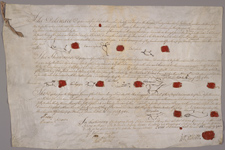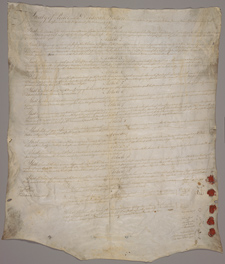
Vanished Worlds, Enduring People
European Encroachment, Native Resistance
Treaty of Peace with the Delaware Nation, July 1765. [view first image] | [view second image]
The treaty of peace that William Johnson, Superintendent of Indians for the British Crown, signed with the Delawares (Lenni Lenape) in May 1765, codified the end of their participation in the Ottawa leader Pontiac’s 1763-64 rebellion against the British. This addendum to the treaty was added to secure the submission of the Ohio Shawnees and Mingos. The end of the French and Indian War earlier that year left his Ottawa (Odawa) territory in the Great Lakes area under British supervision, and helped spark Pontiac’s uprising. Pontiac and the Ottawas, backed up by Wyandots (Wendat), Potawatomis, and Chippewas (Anishinaabe), besieged the fort at Detroit, while his Delaware (Lenni Lenape), Mingos (Seneca-Cayuga), and Shawnee allies overwhelmed many British outposts, including Sandusky, Michilimackinac, and Presque Isle. The eastern allies were subdued during Colonel Henry Bouquet’s 1764 Ohio campaign. The 1765 treaty codifies the Indians’ capitulation. Pontiac, himself, signed a separate treaty with William Johnson in 1766 and was pardoned by the British.
